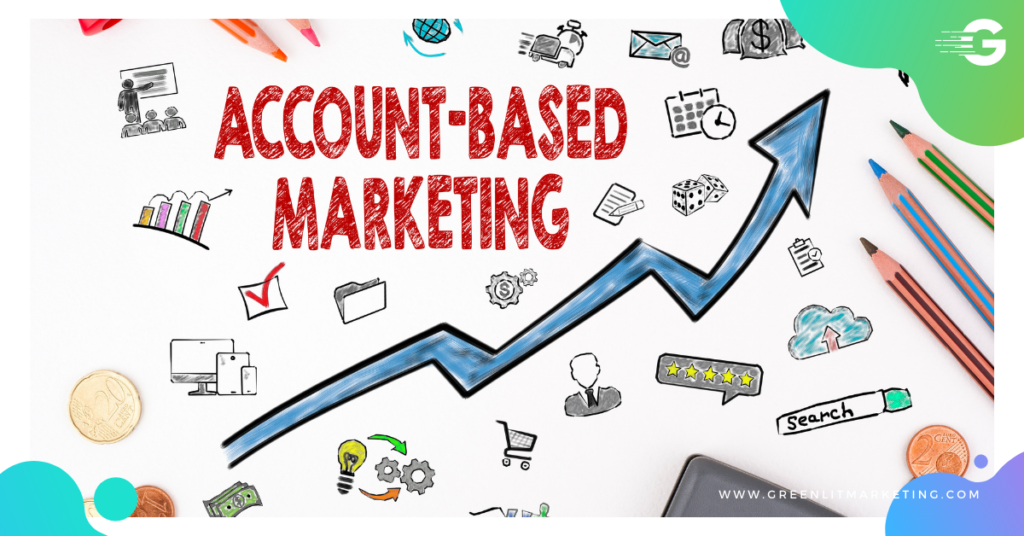It’s been decided. Your company will have an account-based marketing (ABM) program. Before you start getting overwhelmed about creating and implementing the program, and before you start geeking out about the technology and tools you just HAVE to have to be successful, it’s important to have the basics in place too. In fact, the tools aren’t what make ABM successful. Rather, it all starts with data. Then, an effective content strategy is a must. Metrics, attribution and testing are all also vital to success as well. Let’s jump in!
It All Starts with Data
In the world of account-based marketing, there are so many things to think about: account selection, content, strategy, and metrics are what most people focus on. But of all the elements of a successful ABM program, there are none so critical, or overlooked, as data.
Marketing’s role is to take a broad approach to data by identifying your company’s ideal customer profile (ICP) and building out the names of your target buyers and influencers by company. A sales-driven research component is needed to fill in the gaps.
The first step is to invest in a DaaS, or data as a service, where you can identify your target prospects to load into your CRM or marketing automation system. There are many tools, each with its own benefits and challenges.
DiscoverOrg and Zoominfo are arguably the most popular options. Another DaaS that is gaining popularity is Synthio. Synthio enables marketers to get very specific about the data they’re pulling, save unlimited templates, and easily upload lists of companies, titles, or NAICS code to reduce input time. It has the added benefit of telling you more about the person than you could ever need to know, including their exact GPS coordinates. The data is extremely reliable as they pull from self-reported sources (think LinkedIn and other resume sites). The firmographic data shows both the headquarter and subsidiary company in addition to the exact contact city and country. This is especially helpful if your target is a global enterprise company where you need to identify satellite offices and contacts in other countries.
Having a high-quality data source enables sales and marketing to easily identify the total addressable market (TAM) of a large enterprise company. Instead of building out accounts based on all the locations associated with that company, take an account-based marketing focus by first determining the critical mass of target prospects by location. Building only the accounts that matter to your business will enable you to report on account-penetration metrics and have a more effective field marketing strategy.
Sales Collaboration
Partner with the sales team on an outbound strategy. It’s everyone’s responsibility to work on data. The account executive needs to help determine where there are gaps in the data and work on filling in those gaps for your target accounts with a more qualitative approach using other data tools. Where there is incomplete information, like a contact that is missing an email, sales can use tools like LinkedIn’s InMail to connect.
Another outbound strategy is to focus on website traffic data. Using tools like Demandbase’s Web Analytics, or Marketo’s Inferred Company for a lighter version, you can determine the companies visiting your site. The marketing team can use this information to set up personalized landing pages and the sales team can see who is stealth shopping. Powered by Demandbase, Google Analytics reports can be customized for the sales team to identify site traffic by company, location, industry and behavior.
Cleaning and Augmenting Data
Be sure to work closely with your marketing and sales operations team to ensure that you’re implementing efficient processes for both continually cleaning the database and augmenting data. Decide on how frequently you’ll refresh data based on the frequency of change within your industry and your resources. For new data, monthly is a good rule of thumb. Cleaning should be continual, but quarterly is the bare minimum for maintaining database health.
Keeping your database streamlined and relevant are the fundamental building blocks of data-driven marketing. Establishing a data strategy between sales and marketing will help to ensure that your account-based marketing program is successful.
Refine Your Content Strategy
When developing your ABM content strategy, it’s easy to get caught with a case of the cans. Sure you can develop company-specific personalized content, but should you?
Account-based marketing requires a shift in thinking from quantity to quality, and your content strategy should follow suit. Going deep on personalizing content doesn’t always lead to an exponential increase in conversions. Taking a balanced approach means developing a content strategy that will build a pipeline while maintaining an optimal level of effort. This is one of the top ABM lessons every marketer should know.
An ABM content strategy starts with an audit of existing collateral and a roadmap of how and where content will be used. Then think about your key performance indicators (KPIs) and test first before creating ABM-specific collateral.
Content Audit: What’s Working, What’s Not?
Take stock of your existing content by creating a content audit. List all the attributes of each piece, including the type of content it is (whitepaper, case study, feature sheet, webinar, video, etc.) applicable stages of the buying funnel, use case, industry, target audience or any other relevant categories to your business. Include the date it was created and when it was refreshed. Be sure to do your due diligence to confirm that featured customers are still with the company and that quotes align with your brand messaging.
This is also a good time to examine the performance of your content. Look at the metrics to determine which assets are most attractive (click-through rate) and most relevant (conversion rate). You may find that there are only a few pieces that are popular and relevant to your ABM campaign, and that’s okay. Many companies are suffering from too much content. Recently, at a sales and marketing roundtable held in the Bay Area, a senior level marketer from a large global software company announced they had gone on a content diet reducing their collateral by 80%. Of their hundreds of content pieces, they found that only 20% were being used most of the time.
Content Roadmap for the Marketing-Sales Funnel
Once the content audit is complete, it’s time to develop the funnel roadmap to identify the content gaps in your strategy.
Most content falls into three main categories:
- What your company is selling (assets that explain your company, product features, and solutions guides)
- Why this is of value to the prospect (competitive information and thought-leadership pieces)
- Who says refers to third-party validation that supports your product claims (customer case studies, analyst reports, partner marketing, sponsored content, and media relations)
These three types of content come into play at different parts of the funnel depending on the action you want the prospect to take. What and why are pivotal in the top-of-funnel strategy where you’re focusing on lead conversion. Who says comes into play in the mid-funnel where your focus is on sales conversion and pipeline acceleration.
Once the ABM content roadmap is developed, look for gaps in content. Ideally, you’ll want to have at least three pieces per stage of the funnel to launch an outbound strategy while your content marketing team is developing any additional collateral you’ve identified. Remember you don’t have to develop new content or put a company-specific slant on the existing content to launch your ABM strategy. Chances are that there’s existing killer content that can be used with a personalized spin on the outbound messaging.
Consider all the players involved in a deal when developing your roadmap and where they come into play. For example, if you’re selling accounting software, your target audience may be the comptroller, but the decision maker may be the CFO. Each member of the buying unit will have different needs that require different collateral. Be sure to include them in your content roadmap.
ROI: the Case for a Balanced Content Strategy
You’ve identified your content gaps and are ready to start developing. Before you begin developing content for each company in your strategic account list, take a baseline measurement of your KPIs in an ABM strategy with generic content. Your inbound and outbound strategies are going to be highly targeted, so your conversions and pipeline should naturally increase. Understanding the impact of a strategy shift is imperative before writing a creative brief for each ABM company.
Once you’ve established baseline metrics, you can start to develop more personalized content. If you have a horizontal product that spans multiple industries, consider first adapting your marketing messaging by industry. This does not require you to go very deep. You can take your top-performing assets and put a vertical spin on them.
When developing company-specific collateral, start small with only a handful of companies so that you can test the conversion rates on the company-specific collateral and compare your return on investment (ROI) to determine if there’s a significant enough lift to make a case for company-specific personalization.
Content is the key to conversions in your ABM strategy. Once you have your plan in place, you’ll want to apply different strategies for the different types of accounts and layers of the funnel.
Metrics, Testing, and Attribution for Success
It is important to remember in account-based marketing that because you’ve already identified the target, responding to your outbound campaign or inbound efforts means that the person is already qualified. They are pre-qualified per se because you know they already fit the demographic and firmographic standards agreed upon by both marketing and sales.
So why then should they be treated with an inbound demand generation waterfall label?
In ABM, everyone is a marketing-qualified lead (MQL), so developing a path of response that addresses this structure change is imperative to your metrics. You cannot measure an ABM campaign with traditional inbound metrics.
As marketers, we must continue to test and optimize our programs, content, and messaging to achieve the perfect balance between effort and return. The things that we measure—click-through rates, open rates, and ROI by program—are less important to the CEO who is mainly concerned with the pipeline.
These are the top marketing metrics to learn if your programs are working by job function.
Inbound
- Website: Conversions, time on site, bounce rates, organic traffic
- Paid media: Click-through rate (CTR) to determine whether your message is effective; conversion rate to determine whether the offer is compelling enough
Outbound
- Email: Deliverability to determine the health of your list; unsubscribe rate to identify whether your email cadence is correct; and CTR to see whether your message is compelling enough
Events
- Field: Opportunities; total ICP penetration (how many attendees fit the profile of who you are looking to target), how many talked to you, how much pipeline was opened
- Online: Engagement within your webinar, attendee rate, overall viewership (live plus on demand); Total ICP penetration
Metrics By Role
| Your CEO cares about: | Your chief marketing officer (CMO) cares about: | Sales cares about: |
|
|
|
Attribution
It’s important to recognize that content is there to help, but when we talk about account-based marketing, we’re ultimately talking about B2B sales. Rarely do customers buy because they’ve read one article on your site. Still, when it comes to attribution, there’s the initial source of the lead (lead conversion) and then there’s the pipeline conversion. Many people apply the 20|20|80 rule, which is to allocate pipeline attribution by 20% to initial lead capture conversion, 20% to the final marketing touch prior to conversion (within a reasonable time period, like 30 days) and then 80% of the pipeline is evenly distributed among all the marketing tactics in between.
That helps marketers to fully understand how their programs are performing. However, when you’re specifically examining content, you’ll want to make allowances for the methods: For example, a piece of content read from an outbound email versus discovered while browsing the site holds different values given that both push and pull should be measured differently.
Test, Test, and Test Again
There are multiple ways in which you can A/B test what is working and what isn’t in ABM. Remember for an A/B test to be accurate, you’ll need to have a sample size greater than 1,000, which is not always possible in account-based marketing. The easy way to test messaging is with advertising given that you have high exposure and easily tracked CTRs and conversion rates. Advertising platforms like Terminus will allow you to target your ABM company so you can test a generic message versus an industry message versus a company-specific message to see which performs the best. Try testing a personalized message on the same collateral versus personalized collateral with a generic message. And remember, it’s important to minimize the number of variations per ad. Whether it be copy, color, or collateral, only make one change at the time so you can narrow down what is truly catching your ABM prospect’s attention.
Account-based marketing can be an excellent way to drive your pipeline and turn more MQLs and SLAs. However, there needs to be a balance between effort and result. By focusing on data quality, strategy, and the right metrics, you can help maximize your ABM success. If you’re not sure how to get started, book a consultation with GreenLit Marketing. We can help you implement an ABM strategy that works.



